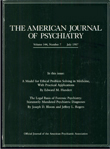Interaction of Fluoxetine and Valproic Acid
Ms. A, a 26-year-old obese woman, was referred because of the weekly occurrence of generalized seizures and pseudoseizures. Treatment with valproic acid was initiated, and the dose was titrated up to 2000 mg/day. The patient's valproate serum levels were routinely monitored, and the level (78 mg/liter) was always within the therapeutic range (50–120 mg/liter). She did not receive other drugs. One year later Ms. A developed major depression with binge eating episodes. She was started on fluoxetine, 20 mg/day, and after a week the dose was increased to 40 mg/day. Partial control of symptoms was obtained within 1 month after initiation of fluoxetine, but her valproate serum level (126 mg/liter) had risen above the therapeutic range and remained essentially unchanged (131 mg/liter) 20 days later. The patient was informed about the pharmacological interaction, and she agreed to the withdrawal of fluoxetine. Subsequent serum level monitoring showed a gradual reduction of valproic acid levels (week 2: 105 mg/liter; week 3: 87 mg/liter). The patient continued to take the same dose of valproic acid, achieving good seizure control.
References
Information & Authors
Information
Published In
History
Authors
Metrics & Citations
Metrics
Citations
Export Citations
If you have the appropriate software installed, you can download article citation data to the citation manager of your choice. Simply select your manager software from the list below and click Download.
For more information or tips please see 'Downloading to a citation manager' in the Help menu.
View Options
View options
PDF/EPUB
View PDF/EPUBGet Access
Login options
Already a subscriber? Access your subscription through your login credentials or your institution for full access to this article.
Personal login Institutional Login Open Athens loginNot a subscriber?
PsychiatryOnline subscription options offer access to the DSM-5-TR® library, books, journals, CME, and patient resources. This all-in-one virtual library provides psychiatrists and mental health professionals with key resources for diagnosis, treatment, research, and professional development.
Need more help? PsychiatryOnline Customer Service may be reached by emailing [email protected] or by calling 800-368-5777 (in the U.S.) or 703-907-7322 (outside the U.S.).

